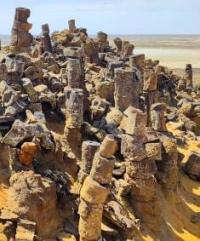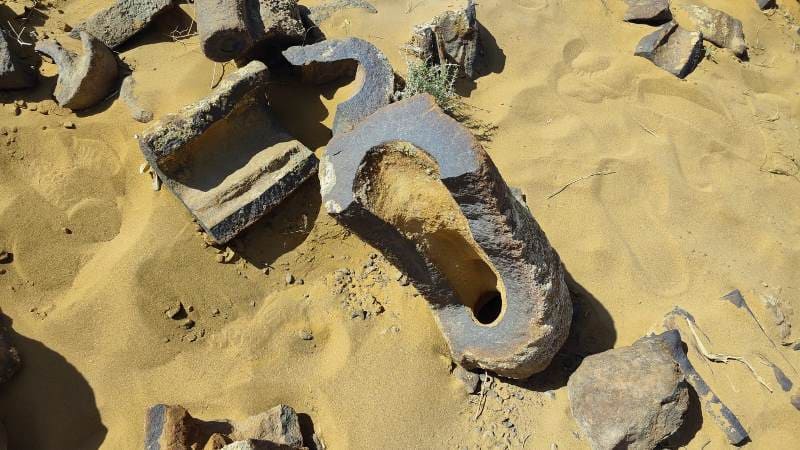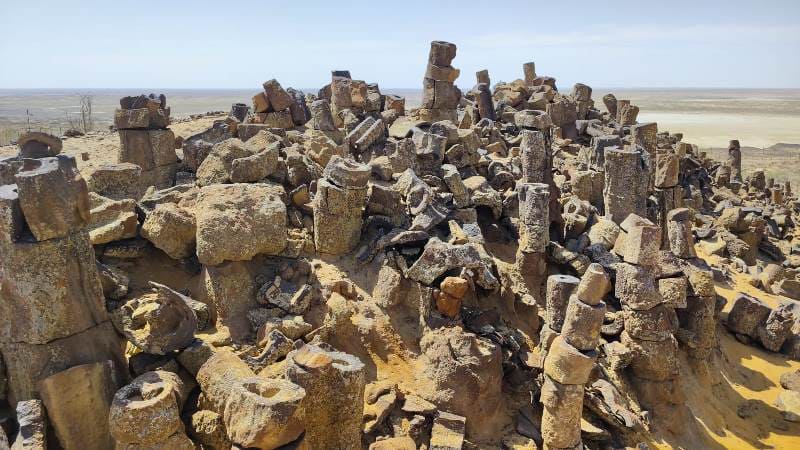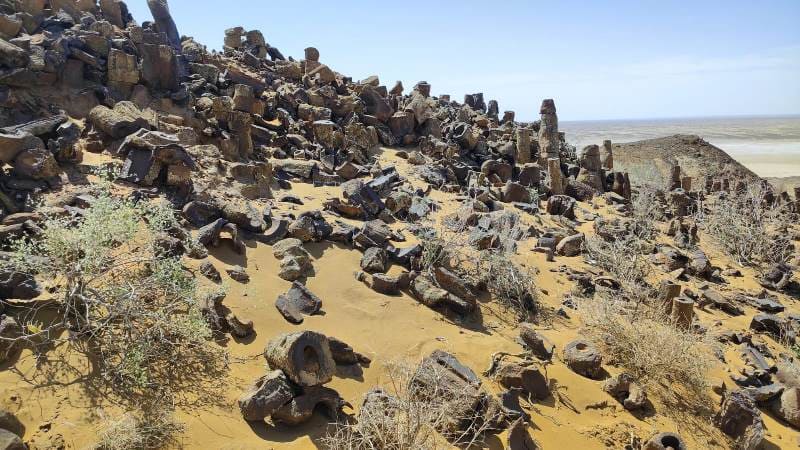You are here
"Stone Forest" Dzharakuduk.

Sights of Kyzyl-Kum desert.
“Every day something new in the world rocks the sky,
Before which human witty calculation retreats.
Let our minds, like the golden sun, sparkle from the heights,
He will never find a solution to the riddles of fate.”
Muhammad ibn Ali As-Samarkandi.
Trip to Dzharakuduk valley from Tashkent.
Dzharakuduk valley is located at an altitude of 185 meters above sea level, located 22.5 kilometers southwest of village of Mingbulak, in central part of Kyzyl-Kum desert, 43.9 kilometers northeast of Buzaubay railway station, 74 kilometers to west and slightly south of town of Uchkuduk, in Uchkuduk district, Navoi region.
The “Stone Forest” of Dzharakuduk is located 24 kilometers west of the Mynbulak depression. The “Stone Forest” in the Dzharakuduk tract is a unique natural phenomenon. Literary sources report “dense forests buried standing, located along the banks of ancient inter-basin channels and estuary basins of the first half of the Late Cretaceous period.
Imprints of leaves of plane trees, bay trees, magnolias and other angiosperms were also found here, as well as remains of litter and litter preserved in some places.
These data confirm the work of naturalist researchers:
“Not far from Dzharakuduk, areas were discovered where “antediluvian forests” grew many millions of years ago along the shores of warm sea bays and lakes...
Later they were covered with layers of sea and river sediments. The wood became mineralized and petrified, but retained its original appearance and structure. In the oldest layers of soil exposed in the steep slopes of gorges near Dzharakuduk, dinosaur bones are also found.”
Today this place is well known and studied by scientists and geologists. Over the past hundred years, many sensational discoveries have been made here. In particular, research was carried out by the Institute of Mineral Resources of the Republic of Uzbekistan.
In terms of the variety and number of finds, there is no other place like it in the world. On an area of 30 square kilometers, among stone piles, cuts, and coastal sea formations, stone structures reminiscent of the sound pipes of a Gothic organ are visible.
These are petrified trunks of an ancient forest. Upon careful examination, remains of wood were found in the internal cavity of the tubular body, carbon analysis of which confirmed its ancient age. This circumstance made it possible to assume that the plant trunks secreted some kind of “sticky”, sticky liquid, onto which grains of sand actively stuck, creating the shape of “pseudo-trunks”.
When these formations are split open, leaf imprints are found inside with a fairly high degree of preservation, which confirms the biogenic origin of the “stone” forest. But this is not the only version in an endless series of arguments and hypotheses.
A significant contribution to the knowledge of the nature of the formation of Cretaceous deposits in the Kyzylkum desert and the stone forest of the Dzharakuduk tract was made thanks to the activities of the international expedition URBAC (Uzbekistan, Russia, Great Britain, America, Canada), headed by James David, professor of paleontology from San Diego (California, USA). Archibald.
The research of this expedition is devoted to dinosaurs of the Cretaceous period that lived in the area of the modern Kyzylkum desert. Sections of the soil deposits of the tract are literally stuffed with the remains of organisms, among which fragments of the skeletons of vertebrates and reptiles predominate.
The collection of finds was supplemented by many amphibian teeth found here. Complex fossil layers consist of layers of clay, freshwater and marine sediments, sandstones and other rocks. All this indicates that the territory of Kyzyl-Kum was once part of the world ocean.
It will take a lot of effort to imagine a picture of fabulously beautiful lagoons washing the sandbanks. Exotic species of coastal vegetation, giving way to thickets teeming with all kinds of insects and fauna of that time. Thanks to the mild, warm climate of the Cretaceous period, indicated on the time scale from 150 to 60 million years BC, and many other factors, ideal conditions were created on Earth for the realization of nature's most unpredictable fantasies.
There was everything here - from the smallest planktonic organisms (farominifera) and golden algae (coccolithophores), which later turned into rock (white chalk), which gave the name to the entire system, to ichthyosaurs and plesiosaurs reaching more than 15 meters in length.
Leading scientist L. Nesov made a great contribution to the study of the reserve. Long-term collaboration between L. Nesov and D. Archibald had a very fruitful effect on the study of the life of fossil dinosaurs, turtles, sharks and other inhabitants of the Cretaceous landscapes of Eurasia.
These studies are continued by a new generation of scientists and geologists. New finds and discoveries undoubtedly await them ahead.
Geographic coordinates of Dzharakuduk valley: N42°06'45 E62°40'44



Authority:
Alexander Luzanovsky, candidate of geological and mineralogical sciences, senior researcher, deputy head of the educational and methodological office of the Training Center of the Central Mining Administration of the State Enterprise NMMC.
Fazil Abduraupov, member of the creative association of journalists of Uzbekistan.
Photos by:
Roman Stetsenko, Almaty.







